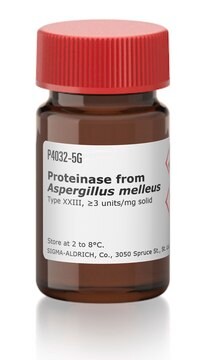P4850
Protéinase K from Tritirachium album
buffered aqueous glycerol solution, for molecular biology, ≥800 units/mL
Synonyme(s) :
Endopeptidase K
About This Item
Produits recommandés
Qualité
for molecular biology
Niveau de qualité
Forme
buffered aqueous glycerol solution
Poids mol.
28.93 kDa
Concentration
≥10 mg/mL
≥800 units/mL
Impuretés
≤0.5 ppm DNA (PicoGreen® assay)
Activité étrangère
DNase, Nickase and RNase, none detected
Température de stockage
2-8°C
Vous recherchez des produits similaires ? Visite Guide de comparaison des produits
Application
Élimine les endotoxines qui se lient aux protéines cationiques telles que le lysozyme et la ribonucléase A.
S′est avéré utile pour l′isolement des mitochondries hépatiques, de levure et de haricot mungo.
Détermination de la localisation des enzymes sur les membranes.
Traitement des coupes de tissus incluses en paraffine pour exposer les sites de liaison à l′antigène pour le marquage par anticorps.
Digestion des protéines des échantillons de tissu cérébral pour la recherche sur les prions responsables des encéphalopathies spongiformes transmissibles (EST).
- in bovine endometrial epithelial cells for herpes viral DNA extraction
- for viral RNA extraction from nasal swabs
- as a component of phase lock and direct PCR lysis buffer
Actions biochimiques/physiologiques
Définition de l'unité
Forme physique
Informations légales
Mention d'avertissement
Danger
Mentions de danger
Conseils de prudence
Classification des risques
Resp. Sens. 1
Code de la classe de stockage
10 - Combustible liquids
Classe de danger pour l'eau (WGK)
WGK 2
Point d'éclair (°F)
Not applicable
Point d'éclair (°C)
Not applicable
Équipement de protection individuelle
Eyeshields, Faceshields, Gloves, type ABEK (EN14387) respirator filter
Faites votre choix parmi les versions les plus récentes :
Déjà en possession de ce produit ?
Retrouvez la documentation relative aux produits que vous avez récemment achetés dans la Bibliothèque de documents.
Les clients ont également consulté
Articles
Proteinase K (EC 3.4.21.64) activity can be measured spectrophotometrically using hemoglobin as the substrate. Proteinase K hydrolyzes hemoglobin denatured with urea, and liberates Folin-postive amino acids and peptides. One unit will hydrolyze hemoglobin to produce color equivalent to 1.0 μmol of tyrosine per minute at pH 7.5 at 37 °C (color by Folin & Ciocalteu's Phenol Reagent).
Protocoles
Proteinase K (EC 3.4.21.64) activity can be measured spectrophotometrically using hemoglobin as the substrate. Proteinase K hydrolyzes hemoglobin denatured with urea, and liberates Folin-postive amino acids and peptides. One unit will hydrolyze hemoglobin to produce color equivalent to 1.0 μmol of tyrosine per minute at pH 7.5 at 37 °C (color by Folin & Ciocalteu's Phenol Reagent).
Notre équipe de scientifiques dispose d'une expérience dans tous les secteurs de la recherche, notamment en sciences de la vie, science des matériaux, synthèse chimique, chromatographie, analyse et dans de nombreux autres domaines..
Contacter notre Service technique







